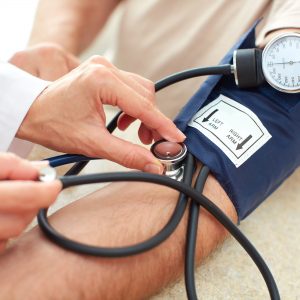When is the last time you had your blood pressure checked? Over one quarter of Australian adults experience high blood pressure, with the likelihood increasing as you age.
It is important to regularly have your blood pressure checked, as regular high blood pressure (hypertension) can often be asymptomatic and go undiagnosed, despite the negative effects it is having on your body. Hypertension can be treated and controlled, however, if it is not, the heart is forced to work harder, putting it under a greater amount of stress and putting you at a higher risk of experiencing a heart attack, stroke, heart failure and kidney disease.
You are not diagnosed with hypertension following the taking of simply one high measurement, rather if it is measured higher than normal by your doctor it will be measured with multiple readings that occur at different times and across different days before being diagnosed. This is because blood pressure changes all the time to deal with the situation you are in, even a change in posture or position can alter it. For example when exercising your blood pressure increases to make sure there is adequate blood being pumped around the body to handle the increased workload. Emotional state, sleep and anxiety can also increase blood pressure, and even the nervous feeling some people feel when being tested at the doctors can raise the pressure and this is commonly called ‘white coat syndrome’. This constant changing of blood pressure is why it is important to not only go by one reading.
How does my blood pressure get taken?
Blood pressure is measured with a cuff that is placed around your arm called a sphygmomanometer (try saying that 10 times fast). The cuff inflates restricting blood flow and then begin to slowly deflate with either a machine or a health professional measuring the flow with a stethoscope to get your reading. So what does it actually measure? It measures the pressure in the arteries that travel blood around the body as a result of your heart beating. When it is measured it will involve the recording of two numbers, for example, 120/80. Sound familiar?
What does it mean?
The top number is the systolic number and represents the pressure in your arteries when the heart beats. The bottom number represents the pressure in the arteries when the heart is resting in between beats and filling with blood and is called the diastolic. Unfortunately as we age our systole number in our blood pressure does tend to be on the increase. This occurs for a variety of reasons including a loss of elasticity in the arteries, as well as a build up plaque.
Is my blood pressure too high?
When we discuss what a good or normal blood pressure is there is no exact figure that describes everyone as factors including medications you are taking can alter it. However, here are some good figures to go by from the heart foundation.
- Normal blood pressure: generally less than 120/80 mmHg (i.e. systolic blood pressure less than 120 and diastolic blood pressure less than 80 mmHg).
- Normal to high blood pressure: between 120/80 and 140/90 mmHg.
- High blood pressure: 140/90 mmHg or higher. If your blood pressure is 180/110 mmHg or higher, you have very high blood pressure.
Can I do anything to help keep my blood pressure in a safe range?
Lifestyle modification is great for controlling and preventing high blood pressure and also can reduce the risk of experiencing cardiac events. This involves taking part in physical activity, healthy eating and even relaxation techniques. Medication is also commonly prescribed and can be a great way for keeping blood pressure within a safe range. There are some foods and exercises that you do need to be wary of if you have hypertension, so if you do, please consult a health professional.

